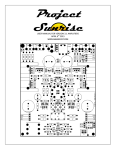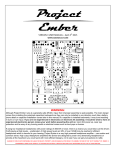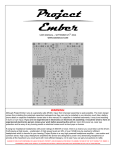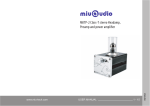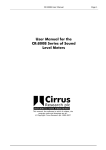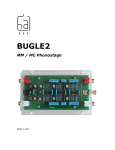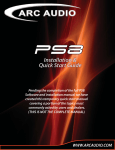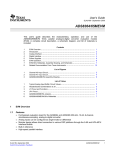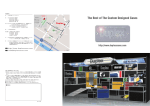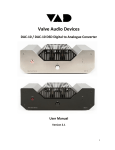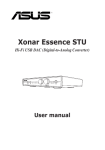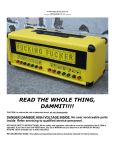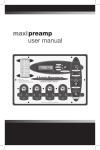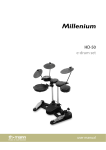Download starlight 1 manual 9..
Transcript
Project Starlight USER MANUAL – SEPTEMBER 25TH 2014 WWW.GARAGE1217.COM WARNING: Although Project Starlight runs at a generally safe 24VDC, Injury from improper assembly is quite possible. The main danger comes from installing the polarized capacitors backwards as they can only be installed in one direction much like a battery (more detail on capacitor installation comes later in this manual) If a capacitor is installed backwards, it may burst resulting in burns or eye injury. If you are not experienced in electronics or electronic kit assembly, it would be wise to have an experienced electronics person review your work before powering the unit on. Upon first power up, wear eye protection and be wary of any burning smells or electrical noises such as loud pops or buzzes. If you followed this installation guide properly and all components are in their proper places and were installed in their proper orientation, you will soon be enjoying your amplifier! GARAGE1217.COM IS NOT RESPONSIBLE OR LIABLE FOR INJURY, PROPERTY LOSS OR DAMAGE AS THE RESULT OF ASSEMBLY OR USE OF THIS “DO IT YOURSELF” KIT. STARLIGHT IS CONSIDERED A HOBBY LEVEL PRODUCT. IT CONTAINS NO ELECTRICAL CERTIFICATIONS AND IS NOT ADVERTISED AS SUCH. USE AT YOUR OWN RISK. Project Starlight Specifications - Opamp output stage - Power consumption: 7.2W peak. - Power supply: 24VDC (0.3A peak) - Input Resistance: 30kΩ - Input Sensitivity (6N23): 270mV (dependent on tube) - Gain: 16dB (dependent on tube) - Max Output voltage (no load): 7Vrms at 120Ω - Output Resistance: Selectable 2.5, 70Ω - Frequency Response: 15Hz – 80 KHz (-0.5dB) with 32Ω load - Frequency Response: 4Hz – 230 KHz (-3dB) with 32Ω load - Signal to Noise ratio: 91dBA (dependent on tube) - Crosstalk: -87dB (dependent on tube) - THD: > 0.015% (dependent on tube) - Suitable for: 16-300Ω Headphones Tubes / Valves that can be used in Project Starlight 6V TUBES: 6922 7308 8223 6AQ8 6DJ8 6GU7 6CG7 6BQ7A 6H23 6H23N 6L12 6N11 6N23 6N2P 6N6P 6N30P B719 Cca CV2492 CV2493 CV5358 E88CC E89CC, E188CC E189CC E288CC ECC85 ECC88 ECC89 ECC188 ECC189 ECC288 ECC289 JAN 7308 6GM8 6N27P ECC86 12V TUBES: 5751 5814 5814A 5963 6189 6201 6681 7025 7058 7729 6L13 12AD7 12AT7 12AU7 12AX7 12BH7(A) 12DF7 12DM7 12DT7 A2900 B152 B309 B329 B339 B749 CV0455 CV0491 CV0492 CV4024 E81CC E82CC E83CC 12V TUBES CONTINUED: E181CC E183CC E283CC E811CC E812CC E813CC E2157 E2163 E2164 ECC81 ECC82 ECC83 ECC181 ECC182 ECC182 ECC801 ECC803 ECC803S Verified Opamp options and info Several opamp options outside of the default 4562's can be used. To the right is a list of opamps verified to work in dual / quad configurations in Project Starlight. A pair of opamps can be run VS. quads to keep costs lower when rolling or trying new types (quads increase output power) Verified Opamps: - LM4562 (default) - NMJ4556 - OPA2132 - OPA2134 - OPA2227 - NE5532 If running a pair of opamps (1 per channel) only use the inner sockets IC1-2 and IC1-3 Example of quad opamps installed Project Starlight Thank you for purchasing the Project Starlight Headphone Amplifier Kit. This kit requires minimal electronics and soldering knowledge. The layout is easy to follow and setup is a snap! Please make sure to follow the instructions outlined in this guide and you will be enjoying your amp in no time. First, lets go over the tools and items required for your build which are as follows: Required Assembly Tools: - Soldering iron, 25W minimum – Variable temp soldering station preferred with 1.5 – 2mm wide chisel tip - .032 diameter 60/40 or 63/37 Tin/Lead solder is recommended. Lead free is difficult to work with and not recommended - Magnifying glass (recommended but not required) - Rubber Gloves (recommended but not required) - 3M Green or Red Scotch Brite (recommended but not required) - 3/32th Allen Key - 5/64th Allen Key - Flush cuts - 90% Isopropyl alcohol (recommended but not required) - Paper Towels (recommended but not required) - Digital Multi Meter (DMM or DVOM) Before You Start Soldering: Prep work needs to be done. Wash your hands thoroughly and dry. Put on the recommended rubber gloves and scrub down the PCB (circuit board) on both the front and back side with 90% isopropyl alcohol to clean any residuals off of the board from manufacturing. Once the board has been cleaned, set it on a dry paper towel out of the way. Try to use the rubber gloves during the entire assembly process to keep oils off of the board and solder joints. Proper soldering is key to a quality final product. If you are new to soldering, here are some basic guidelines to follow. It would be wise to buy a copper project board and a few cheap resistors or other components to practice with before starting this project. Soldering and Solder Joints: - For best results and maximum conductivity of any component, Wipe each lead down using Scotch Bright. Only one or two passes are required, making sure all of the surface has been cleaned. This removes oxidation or any other build up on the metal that has accumulated over time. Once cleaned, it is a good idea the further clean the wire leads with 90% isopropyl alcohol. Make sure all alcohol has evaporated prior to soldering as alcohol is VERY FLAMMABLE. - Do not use to much or to little solder on each joint. See images below to get an idea of what you should be looking for - The idea is to heat the pad and the component wire lead quickly and efficiently so that solder flows to each equally. Wetting the tip of your iron with a very small amount of solder will aid in quickly heating up the pad and wire lead. - Having to heat the component for long periods of time, especially capacitors is not a good thing. When soldering capacitors, heat them only long enough to ensure a quality joint and let the unit cool down for a few minutes before soldering the other side (especially on small capacitors) - The solder joint should look bright and metallic. A dull or dark gray looking joint is referred to as a “cold solder joint” Cold solder joints may not pose a problem initially, but can show up later in the amps life. - After every solder joint, make sure to clean the flux off your soldering iron tip with a wet sponge that should be provided with your soldering iron kit. CUTAWAY OF A VIA AND SOLDER PAD PRIOR TO SOLDERING: VIA / HOLE PCB CUTAWAY SOLDER PAD WIRE LEAD PROPER SOLDER JOINT: IMPROPER SOLDER JOINT: - Solder is bright and shiny. It is curved smoothly starting at the edge of the solder pad until it reaches the lead from the component - Solder should fill the via and flow through the board slightly. It is ok to add solder to the top side of the board, however it is not required - A large blob of solder, often dull in color is not desired. The solder may not flow into the via hole and cause a poor connection or failure later in the amplifiers life. TOP OF PCB TOP OF PCB Project Starlight Project Starlight Operation Guide: Normal Operation and Notes: - Plug in the amplifier and then the power supply (in that order). Make sure the tube, headphone jack and input RCA’s are secure. Once the amplifier is turned to the ON position, the amplifier will enter a protection state for approximately 45 seconds while the tube warms up - When the protection circuit activates and de-activates, a slight click may occur - Depending on the tube type chosen and the sensitivity of headphones used, background noise (hiss) may be present. Choosing a higher output impedance setting, or a lower gain tube can generally eliminate any background noise with sensitive headphones. This does not mean a high gain tube cannot be used in our designs. Selecting a higher output resistance or lower input gain setting will reduce noise with higher gain tubes. We advise you experiment with several tubes to find out what you like best - Some channel imbalance below 9 o’clock on the volume potentiometer is normal. We recommend you adjust your source output levels and use Project Starlight with a volume setting of 9 o’clock or greater - Some faint scratch when turning the volpot is normal. This does not indicate a bad volpot – just a micro amount of DC that is present with certain tubes. This type of scratch is generally only heard with no music playing / rotating the volpot - Cell phones, radio frequency devices or cheap SMPS power supplies in close proximity to Project Starlight may create noise that is audible when listening to music (generally clicks or digital noises) Amplifiers with exposed / visible tubes are susceptible to these types of noises. - Clean your Project Starlight with a microfiber cloth and plastic cleaner (dusting with a microfiber cloth is generally all that is required). Compressed air is also great option for dust. - Project Starlight can supply 1A of heater current to the chosen tube ensuring even the hardest to power tubes such as a 6n6p or 6n30p can be used - Hot swapping tubes is not recommended (swapping tubes while the amplifier is on). Even though it does not cause technical errors or malfunctions it could damage headphones rated for 1W or less. Project Starlight Bottom Chassis Prep / Final Chassis Assembly: - ONCE THE PCB HAS BEEN ASSEMBLED, ASSEMBLE EACH OF THE 4 RUBBER FEET AS SHOWN, ATTACHING EACH FOOT TO THE GRAY SET IT ONTO THE FOUR THREADS STICKING OUT OF THE BOTTOM GRAY SMOKED ACRYLIC BOTTOM CHASSIS ACRYLIC CHASSIS THAT YOU PREVIOUSLY ASSEMBLED. THREADED SPACER GRAY ACRYLIC BOTTOM RUBBER FOOT NYLON WASHER 4-40 BUTTON CAP SCREW - THREAD ON EACH OF THE FOUR HEX STANDOFFS ONTO THE THREADS THAT ARE NOW PROTRUDING THROUGH THE PCB, SECURING THE PCB TO THE GRAY ACRYLIC CHASSIS BOTTOM. PROCEED TO POWER ON THE UNIT (AS DESCRIBED ON PAGE 2, WEARING EYE PROTECTION AND AT A SAFE DISTANCE IN CASE OF A MISTAKE IN ASSEMBLY) - ONCE THE AMPLIFIERS FUNCTIONALITY HAS BEEN TESTED AND THE UNIT HAS HAD A CHANCE TO FULLY WARM UP FOR 30 MINUTES, SET THE BIAS AS DESCRIBED LATER IN THIS MANUAL BEFORE PLACING THE TOP CLEAR ACRYLIC COVER IN PLACE ALLEN BOLT WASHER CLEAR ACRYLIC TOP STANDOFF PCB THREADED SPACER GRAY ACRYLIC BOTTOM Project Starlight Assembly Guide Project Starlight STEP 1: POPULATE ALL SMALL COMPONENTS ON THE BOARD SUCH AS RESISTORS, RIGHT ANGLE JUMPERS, DIODES AND SMALL CAPACITORS. THROUGHOUT YOUR BUILD, ALWAYS INSTALL THE SMALLER PARTS FIRST, WORKING YOUR WAY UP TO THE LARGER COMPONENTS PAY CLOSE ATTENTION TO THE GRAY BAND ON EACH DIODE AS THEY ARE DIRECTIONAL FLAT SPOT OR THE SHORT LEAD ON RED LED (INDICATES NEGATIVE SIDE OF LED) MUST FACE EXACTLY AS SHOWN FLAT SPOT OR THE SHORT LEAD ON RED LED (INDICATES NEGATIVE SIDE OF LED) MUST FACE TUBE SOCKET AS SHOWN INSTALL LED COLOR OF YOUR CHOICE HERE (CHOSEN AT TIME OF PURCHASE) PAY CLOSE ATTENTION TO THE BLACK BAND ON EACH OF THESE FOUR DIODES AS THEY ARE DIRECTIONAL Project Starlight STEP 2: POPULATE ALL MID SIZE COMPONENTS SUCH AS RCA’S, POWER COMPONENTS, SMALL CAPACITORS, TUBE SOCKET, RELAY, TRIMMERS AND SO FORTH PLEASE NOTE: CENTER PIN OF DC SOCKET IS POSITIVE / 24VDC+ INPUT CAPACITORS ARE BIPOLAR MEANING THEY HAVE NO STRIPE AND CAN BE INSTALLED IN EITHER DIRECTION POLARIZED CAPACITORS MUST BE INSTALLED IN THE CORRECT DIRECTION (WILL HAVE A STRIPE DOWN THE SIDE DESIGNATING POLARITY) INSTALL THIS STRIPE FACING THE FLAT SPOT ON THE CAPACITOR OUTLINE ON THE BOARD CORRECT INCORRECT Project Starlight VOLPOT GROUNDING GROUNDING THE VOLUME POTENTIOMETER IS REQUIRED AS WITHOUT IT, THE AMPLIFIER MAY BE SUBJECTED TO NOISE / INTERFERENCE. THE IMAGES ARE OF THE PREVIOUS GENERATION SUNRISE, HOWEVER THE GROUNDING PRINCIPAL IS EXACTLY THE SAME. FIRST, INSERT A WIRE LEAD INTO THE RIGHT SIDE VIA NEXT TO THE VOLPOT AND SOLDER IN PLACE. WRAP THE WIRE LEAD AROUND THE THREADED PORTION OF THE VOLPOT AS SHOWN. PUT ON WASHER AND NUT INCLUDED IN THE KIT. ONCE TIGHT, THE VOLUME KNOB MAY BE INSTALLED. Project Starlight STEP 3: POPULATE ALL LARGE SIZE COMPONENTS SUCH AS LARGE CAPACITORS AND EXTENDED JUMPERS USE THE EXTENDED 3 PIN HEADERS IN THESE LOCATIONS – DO NOT USE A SHORT 3 PIN HEADER! Project Starlight COMPLETED STARLIGHT LAYOUT AND PHOTO: Project Starlight Easy Set Bias Adjustment - Easy set bias makes adjusting tube bias quick and easy. You can access the channel selector for the Easy Set Bias from the outside of the chassis without having to take off the top cover. Dial in the bias by turning the blue trimmers clockwise if bias for the channel is low or counter-clockwise if the bias for the channel is high. Rotate trimmer until both LED’s turn off. To set, make sure to turn off any music source playing into the amp and turn the volume down to its lowest setting HOW TO SET BIAS USING THE EASY SET BIAS FEATURE CHANNEL TESTING OFF RIGHT CHANNEL BIAS TEST SETTING LEFT CHANNEL BIAS TEST SETTING BOTTOM LED GLOWING = BIAS VOLTAGE LOW TOP LED BRIGHT = BIAS VOLTAGE HIGH BOTH LEDS OFF = CORRECT BIAS VOLTAGE ROTATE TRIMMER CLOCKWISE TO RAISE BIAS VOLTAGE ROTATE TRIMMER COUNTERCLOCKWISE TO LOWER BIAS VOLTAGE Project Starlight Project Starlight has several jumpers settings to customize the amp the way you would like it. Below gives you the details on what these jumper settings do! THE 6V / 12V JUMPER ALLOWS YOU TO USE BOTH 6 AND 12 VOLT TUBES. BEFORE POWERING ON YOUR AMPLIFIER, YOU MUST MAKE SURE WHAT VOLTAGE YOUR TUBE RUNS AT AND SET IT ACCORDINGLY VIA THE JUMPER. ATTACH THE JUMPER TAB TO THE CENTER PIN AND TO THE SIDE PIN CLOSEST TO THE VOLTAGE YOU DESIRE (6v OR THE 12v SIDE) (EXAMPLE OF 6V SETTING IN RED) TO NOTE: IF IN DOUBT, SET THE AMP TO 12V. IF ONLY ONE CHANNEL WORKS, CHANGE IT TO THE 6V SETTING. YOU CANNOT DESTROY A TUBE IF SET TO THE WRONG VOLTAGE THIS JUMPER ALLOWS THE LED UNDER THE TUBE TO BE TURNED ON OR OFF (EXAMPLE OF LED TURNED ON) OUTPUT RESISTANCE IS CONFIGURABLE BETWEEN 1.5OHM (LOW-R) AND 68OHM (HIGH-R). HIGHER OUTPUT IMPEDANCE WILL HAVE AN EFFECT ON BASS AND TREBLE FREQUENCIES WHICH IS ALSO DEPENDANT ON YOUR HEADPHONE IMPEDANCE. CHANGE THE SETTINGS TO BEST SUIT YOUR DESIRED LISTENING EXPERIENCE (EXAMPLE OF 1.5OHM SETTING IN RED) Project Starlight Resistors R1 = 470K X 1 R2 = 10K X 1 R3 = 220K X 1 R4 = 34R X 1 R5 = 4K7 X 1 R6 = 68R X 2 R7 = 30K X 2 R8 = 2K2 X 2 R9 = 220R X 1 R10 = 4.75R X 8 R11 = 100K X 2 R12 = 1K X 2 R13 = 100R X 2 R14 = 2K2 X 2 R15 = 12K X 1 R16 = 5.1K X 1 R17 = 1K X 1 R18 = 5.1K X 1 Diodes Z1 = BZX79-C22 X 1 Z2 = BZX79-C18 X 1 D1 = 1N4148 X 2 D2 = 3MM LED (YOU CHOOSE COLOR) X 1 D3 = RED LED X 3 D4 = SB240 X 2 Capacitors C1 = 47uF 50V X 1 C2 = 47pF X 2 C3 = 2200uF 35V X 2 C4 = 1uF X 2 C5 = 470uF 10V X 2 C6 = 100uF 10V X 1 C7 = 100nF X 8 C8 = 100uF 10V X 1 C9 = 22uF 35V X 1 C10 = 10uF 50V x 2 C11 = 330uF 100V x 2 Transistors Q1 = BC546B X 2 Q2 = BC560B X 3 Inductor L1 = 100uH X 1 Regulators IC1-1 = LM4562 X 1 IC1-2 = LM4562 X 1 IC1-3 = LM4562 X 1 IC1-4 = LM4562 X 1 IC2 = DC-DC X1 Jacks J1 = HEADPHONE JACK X 1 J2 = TUBE SOCKET X 1 J3 = BLACK RCA JACK X 1 J4 = RED RCA JACK X 1 J5 = POWER INPUT JACK X 1 Jumpers JP1 = EXTENDED 3 PIN X 3 JP2 = 3 PIN STRAIGHT X 1 JP3 = 4 PIN RA X 1 Switches SW1 = POWER SWITCH X 1 Fuse F1 = 2A FUSE Potentiometers / Trimmers P1 = 10K VOLUME POTENTIOMETER P2 = 50K 25T VERTICAL TRIMMER X 2 Relay U1 = 24V RELAY Misc VOLUME KNOB CHASSIS HARDWARE KIT UPPER AND LOWER CHASSIS JUMPERS X 5














